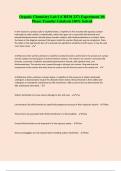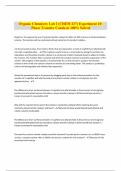Organic catalysis - Study guides, Revision notes & Summaries
Looking for the best study guides, study notes and summaries about Organic catalysis? On this page you'll find 215 study documents about Organic catalysis.
All 215 results
Sort by
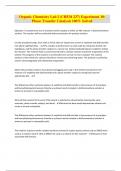
-
Organic Chemistry Lab I (CHEM 237) Experiment 10: Phase Transfer Catalysis 100% Solved
- Exam (elaborations) • 2 pages • 2024
- Available in package deal
-
- £6.46
- + learn more
Organic Chemistry Lab I (CHEM 237) Experiment 10: Phase Transfer Catalysis 100% Solved Objective: To examine the use of a phase transfer catalyst to effect an SN2 reaction in dichloromethane solution. The reaction will be conducted without extraction for product isolation. List the procedural steps, from start to finish, that are required to convert 2-naphthol and allyl bromide into allyl 2-naphthyl ether. - The reaction is performed on a small scale by mixing the alcohol, the haloalkane, ...
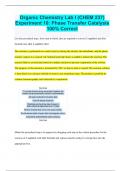
-
Organic Chemistry Lab I (CHEM 237) Experiment 10: Phase Transfer Catalysis 100% Correct
- Exam (elaborations) • 5 pages • 2023
- Available in package deal
-
- £7.27
- + learn more
Organic Chemistry Lab I (CHEM 237) Experiment 10: Phase Transfer Catalysis 100% Correct List the procedural steps, from start to finish, that are required to convert 2-naphthol and allyl bromide into allyl 2-naphthyl ether. The reaction is performed on a small scale by mixing the alcohol, the haloalkane, and the phase transfer catalyst in a conical vial. Sodium hydoxide (base) is added to initiate the reaction. The reaction flask is covered and stirred to conduct reaction to prevent evaporation...
Organic Chemistry Lab I (CHEM 237) Experiment 10: Phase Transfer Catalysis 100% Solved
Organic Chemistry Lab I (CHEM 237) Experiment 10: Phase Transfer Catalysis 100% Solved
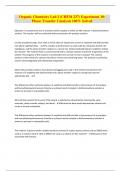
-
Organic Chemistry Lab I (CHEM 237) Experiment 10: Phase Transfer Catalysis 100% Solved
- Exam (elaborations) • 2 pages • 2024
-
- £6.46
- + learn more
Objective: To examine the use of a phase transfer catalyst to effect an SN2 reaction in dichloromethane solution. The reaction will be conducted without extraction for product isolation. List the procedural steps, from start to finish, that are required to convert 2-naphthol and allyl bromide into allyl 2-naphthyl ether. - The reaction is performed on a small scale by mixing the alcohol, the haloalkane, and the phase transfer catalyst in a conical vial. Sodium hydoxide (base) is added to ini...
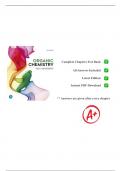
-
Test Bank for Organic Chemistry, 9th Edition by Paula Yurkanis Bruice
- Exam (elaborations) • 935 pages • 2024
-
- £31.93
- + learn more
Test Bank for Organic Chemistry,9e 9th Edition by Paula Yurkanis Bruice. Complete Chapters (Chap 1 to 28) test bank are included with answers. PART 1: AN INTRODUCTION TO THE STUDY OF ORGANIC CHEMISTRY 1. Remembering General Chemistry: Electronic Structure and Bonding 2. Acids and Bases: Central to Understanding Organic Chemistry TUTORIAL: Acids and Bases 3. An Introduction to Organic Compounds: Nomenclature, Physical Properties, and Rotation About Single Bonds PART 2: ELECTROPHILIC ADDIT...
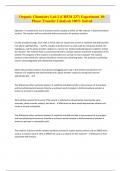
-
Organic Chemistry Lab I (CHEM 237) Experiment 10: Phase Transfer Catalysis 100% Solved
- Exam (elaborations) • 2 pages • 2024
- Available in package deal
-
- £10.09
- + learn more
Organic Chemistry Lab I (CHEM 237) Experiment 10: Phase Transfer Catalysis 100% Solved
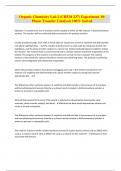
-
Organic Chemistry Lab I (CHEM 237) Experiment 10: Phase Transfer Catalysis 100% Solved
- Exam (elaborations) • 2 pages • 2024
- Available in package deal
-
- £6.86
- + learn more
Objective: To examine the use of a phase transfer catalyst to effect an SN2 reaction in dichloromethane solution. The reaction will be conducted without extraction for product isolation. List the procedural steps, from start to finish, that are required to convert 2-naphthol and allyl bromide into allyl 2-naphthyl ether. - The reaction is performed on a small scale by mixing the alcohol, the haloalkane, and the phase transfer catalyst in a conical vial. Sodium hydoxide (base) is added to ini...
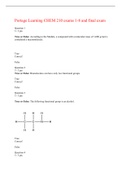
-
PORTAGE LEARNING CHEM 210 exams 1-8 and final exam
- Exam (elaborations) • 124 pages • 2023
-
- £23.44
- 5x sold
- + learn more
Portage Learning CHEM 210 exams 1-8 and final exam Question 1 3 / 3 pts True or False: According to the Module, a compound with a molecular mass of 1,000 g/mol is considered a macromolecule. True Correct! False Question 2 3 / 3 pts True or False: Biomolecules can have only two functional groups. True Correct! False Question 3 3 / 3 pts True or False: The following functional group is an alcohol. True Correct! False Question 4 3 / 3 pts True or False: In ...
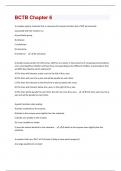
-
BCTB Chapter 6 Questions And Answers With Verified Quiz
- Exam (elaborations) • 20 pages • 2024
- Available in package deal
-
- £6.46
- + learn more
A complex organic molecule that is necessary for enzyme function but is NOT permanently associated with the enzyme is a: A) prosthetic group. B) cofactor. C) holofactor. D) coenzyme. E) metal ion. - D) coenzyme. A double-reciprocal plot of 1/V0 versus 1/[S] for an enzyme in the presence of increasing concentrations of an uncompetitive inhibitor will have lines corresponding to the different inhibitor concentrations that are BEST described by which statement? A) The lines will intersect...

That summary you just bought made someone very happy. Also get paid weekly? Sell your revision notes on Stuvia! Discover all about earning on Stuvia

